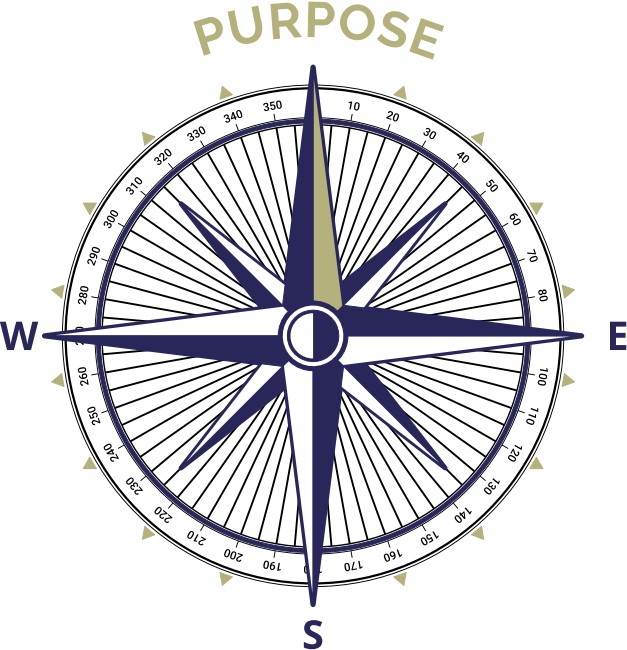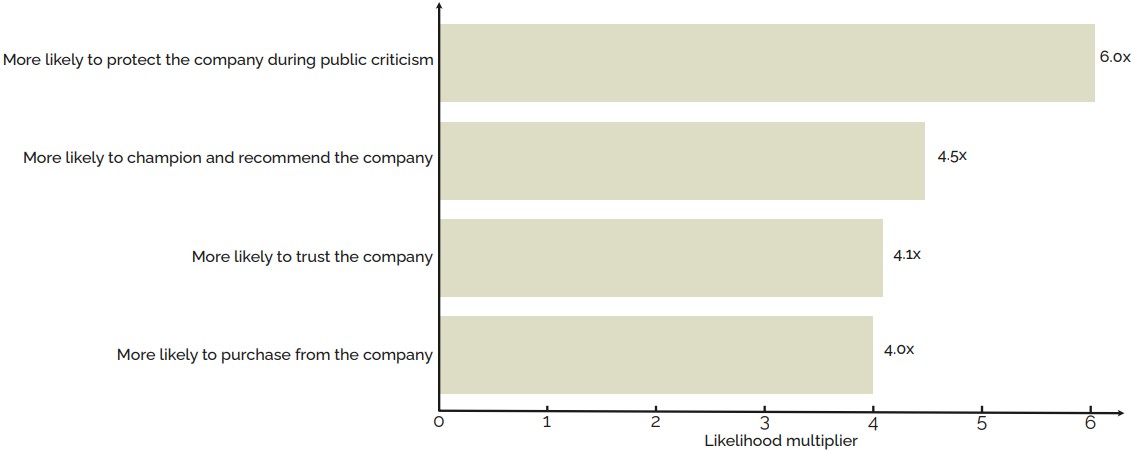INTRODUCTION
Many events can prompt a company to re-examine its culture—whether it’s a new strategy, a merger or acquisition, or a change in leadership. A strong, well-defined culture is essential for navigating these shifts successfully and achieving lasting results
This report explores how Corporate Affairs (CA) plays a critical role in fostering a thriving workplace culture. From embedding purpose as a foundation to forging effective partnerships with HR and driving employee engagement, we delve into the strategies CA leaders can use to inspire transformation and strengthen organisational cohesion.
CHAPTER 1
The Power of Purpose: The First Step in Creating a Thriving Culture
Starting with why
A key starting point for any company looking to evolve its culture is for the CEO and executive team to assess and reflect on its purpose, potentially through internal feedback such as surveys or focus groups. Corporate Affairs (CA) should be aligned with and deeply involved in shaping and articulating this effort. Together, they should ask: What does the organisation stand for, and what is its core reason for being? Is there a purpose that all employees agree on and can articulate? And does that purpose need to be refreshed in light of shifts in the consumer, political or environmental landscapes? By embedding this work within the company’s strategic priorities, CA can help ensure purpose becomes a unifying force that drives both culture and business outcomes.
Aligning employees behind a common purpose can often be a missing piece in driving effective behaviour change. In his bestselling book “Start With Why”, Simon Sinek argued that an inspiring sense of purpose is a highly motivating factor and that the “why” should always come before the “how” and “what” when communicating. Sinek cited Microsoft as a company that – in stark contrast to Apple – had struggled to articulate a clear “why,” focusing instead on products and competition. However, under the leadership of CEO Satya Nadella, Microsoft has undergone a remarkable cultural transformation. Nadella redefined the company’s purpose to “empower every person and every organisation on the planet to achieve more.” This inspiring, enduring purpose, along with a cultural shift emphasizing growth,

collaboration and empathy, contributed to Microsoft’s resurgence as a global leader in cloud computing and its dramatic increase in market value. An organisation’s purpose can act as a North Star, creating relevance, meaning and authenticity behind its actions.
How purpose drives growth
A unifying purpose is more than a nice-to-have or a comms tool. Citing a 10-year study of 50 purpose-led businesses, Deloitte concluded that they “grow on average three times faster than their competitors, all the while achieving higher employee and customer satisfaction.” EY’s research report The Business Case for Purpose found that companies prioritising purpose were more likely to report double-digit growth and successfully implement innovation and transformation efforts. Becoming known for a purpose (as opposed to just a product) can give businesses a deeper connection and increased levels of trust with their audience. For example, Unilever, one of the world’s leading purpose-driven companies, found that its Sustainable Living Brands — those with a clear environmental or social purpose — grew 69% faster than the rest of its portfolio and delivered three-quarters of the company’s growth.
The global “Strength of Purpose” research study of 8,000 consumers by PR agency Zeno found that when people believe a brand has a strong purpose they are four times more likely to buy from that company and six times more likely to defend it in the event of a mistake or public backlash (see below).
Consumer behaviour when they believe a brand has a strong purpose

Caption: Likelihood of consumer behaviour when they believe a brand has a strong purpose vs a brand that does not. Source: Zeno
The study also reveals a striking gap, however: while 94% of consumers believe it’s important for brands to have a strong purpose, only 37% feel that companies actually fulfil this expectation.
Why CA leaders should own company purpose
CA leaders are well-placed to take the lead when it comes to advocating for a strong purpose and ensuring their business is not leaving equity on the table. CA acts as an organisation’s interconnected hub regarding internal and external messaging and narratives. It is also well-placed to address doubts about non-commercial purpose statements or suggestions of greenwashing that could result in scepticism or disengagement.
By bringing in valuable external perspectives — such as NGOs, government, investors, suppliers and customers — CA can build the case for purpose and ground it in external realities. This shared level of understanding can then in turn create buy-in at all levels for creating a culture that delivers on a well-understood purpose.
A purpose statement needs to be much more than a neatly worded sentence or two. In its Purpose Day 2024 report, the Enacting Purpose Initiative noted that there is wide agreement that “corporate purpose is more
than an elegantly phrased statement: it is a foundation for strategy.” To go beyond purpose as a branding initiative, “requires leaders to demonstrate authentic commitment and to be intentional about creating a culture and organisational capabilities that support the purpose.” Whether your stated organisational purpose is commercial, societal or a balance of both, senior leaders need to align to create a purpose-driven culture.
CHAPTER 2
From Silos to Synergy: How Corporate Affairs and HR Can Drive Culture-Building Together.
Forming a new level of partnership with HR
With CA leaders increasingly having a seat at the leadership table and CEOs’ confidence in the CA function increasing (as shown in the Andrews Partnership’s Corporate Affairs Leaders Study), they are well-placed to drive culture transformation. Although the HR function may have been historically seen as the traditional owner of company culture, the work to transform and embed culture must be more wide-reaching. An effective partnership between CA and HR is foundational to embedding a robust organisational culture and may have to begin with both functions shedding any unconscious bias towards each other. CA may perceive HR as owning processes or mere “box ticking,” whereas HR may see CA teams as responsible for “spin.” Neither is true and breaking down these limiting beliefs can help build a deeper, mutually beneficial working partnership that will benefit the business more widely.
As the owners of company narratives and the channels and reach to disseminate messages effectively, there is a clear role for CA in shaping organisational culture. If culture is left siloed within HR there is also a risk that it could stagnate without adequately being brought to life through messaging that also reflects external realities.
With responsibility for hiring strategies and DE&I, HR teams can alter the culture of an organisation through effective recruitment and retention programs — efforts that CA can also influence. HR is also typically responsible for employee surveys, a valuable tool for assessing company purpose and culture. Working closely with HR colleagues on internal surveys is another practical way CA can begin to foster more collaborative relationships.

Forming connections to build culture
In a report by the Saïd Business School at the University of Oxford, one CA leader reflected on their experience working on organisational culture: “HR realised that they couldn’t do culture on their own, so now it is a shared responsibility with us and it works really well that way.” Another CA leader illustrated why their team is the connector at the heart of company culture: “Because of the role we play in being the glue amongst leadership, we have the view across everything, and we can bring the messaging together, and orchestrate that messaging into the rhythm of the business.” Effective collaboration between the two functions helps prevent culture from being managed in a silo, ensuring consistent messaging and levels of understanding across internal teams, the media, government or third-party partners.
When it comes to measurement and insights, the HR function can also provide valuable data and insights on workforce demographics, behaviours and sentiment that should inform communications strategies, allowing CA leaders to craft messages that resonate on a deeper level. Assessing employees’ views on company culture can show the degree of convergence around the company’s perceived cultural attributes. Where convergence is low, employees may see the organisation in varying ways. High convergence can mean high levels of employee engagement and customer orientation but can be more difficult to change if the present culture is not desired.
CHAPTER 3
Culture-Building Strategies: How CA Leaders Can Inspire and Engage Employees.
Building culture through employee involvement
When CA leaders craft messages and engagement experiences that authentically reflect a company’s purpose, they bring culture to life and can inspire employees to connect with their work on a personal level, potentially releasing discretionary effort. Research from Gallup found that businesses with engaged employees ultimately delivered 23% more profit. These businesses create a “culture of engagement” where culture is seen as a point of competitive advantage and employees are more likely to stay, are more productive and deliver better customer outcomes.
For CA leaders, collaborating closely with HR on culture-building initiatives can help ensure all employees feel involved and are part of building and shaping an environment where they can do their best work. A culture that only reflects a narrow segment of the employee base or is skewed towards the experiences of senior leaders will likely cause disengagement and can hinder a company’s reputation and DE&I efforts.
With many companies aiming to tap into consumer sentiment with a purpose that’s focused on more than financial goals, how can CA leaders align communications and engagement strategies with broader social missions? Leveraging employee engagement in ESG initiatives can benefit communities and the environment and help build an engaging and motivating culture. For pharmaceuticals manufacturer AbbVie, employee volunteering is an important part of creating an engaged culture where employees are closer to the patient experience and inspired to innovate to meet complex needs. Its ninth annual “Week of Possibilities” volunteering initiative involved over 900 employees working hands-on across Asia to benefit local communities. Speaking to HRM Asia, Peggy Wu, Asia Regional VP at AbbVie says: “When employees have a purpose, their productivity and motivation are boosted, and they can feel connected to larger social issues.”
Open, two-way communication can also help build trust and engagement that releases discretionary effort. For Singapore-based bank DBS, working with employees to collaboratively create their new values — as opposed to imposing them from the top down — was key. “People support what they help create,” says Yan Hong Lee, managing director and head of group HR at DBS in an interview with McKinsey. Regular CEO town
halls including employee Q&As, skip-level meetings and an open “Tell Piyush” channel where employees can communicate directly with CEO Piyush Gupta and receive a personal reply have all helped build a culture where 91% of workers say they feel DBS is a psychologically safe environment.

Harnessing emotion and role-modelling behaviour
Corporate culture isn’t just built on factual communication of course, it’s also rooted in emotion. When CA leaders infuse storytelling and personal narratives into communications, they can tap into the emotional drivers that make employees feel valued and heard. For instance, when leaders share personal stories of resilience, anecdotes of customer impact that go beyond the day-to-day or moments of unexpected innovation, they can foster a sense of pride and unity within teams. Sharing something personal and being prepared to show vulnerability can build deep levels of trust and help remove perceived divides between leaders and employees.
Role-modelling the behaviour that’s needed to form a successful culture — or to “be the change you want to see in the world” — needs to start at the top. When business leaders create what McKinsey terms a “positive team climate” through consultative and supportive leadership, the organisation is more likely to innovate quickly and adapt well to change. McKinsey’s research found that when senior leaders promote a culture of inclusiveness through behaviours such as seeking out opinions that differ from their own and treating others respectfully, then team leaders are more likely to adopt those behaviours in turn. CA leaders can help coach their colleagues and senior leaders, advocating for and personally role-modelling an open and collaborative communication style within their organisations.
Seizing the culture opportunity
By starting with a clear and authentic sense of purpose, CA leaders can foster alignment across their organisation, ensuring employees are not only informed but also emotionally connected to the company’s mission. Collaborating with colleagues in HR and beyond, CA has a critical role to play in shaping and communicating culture, driving employee engagement and enhancing trust through transparent, two-way communication.
By embracing storytelling, fostering emotional connections and modelling desired behaviours, CA leaders have the opportunity to place themselves at the heart of the rewarding work of building a flourishing culture — work that not only drives long-term business success but can also bring deep professional fulfilment.








